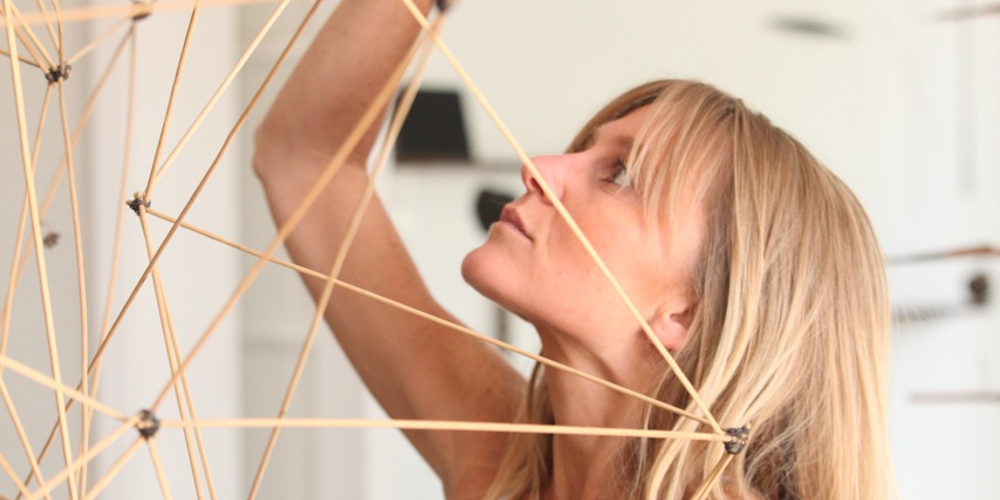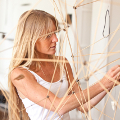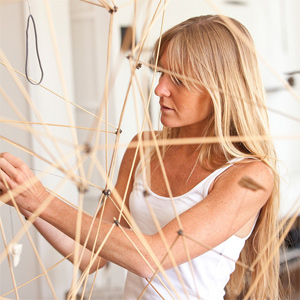 Photo Credits: María Ignacia Edwards
Photo Credits: María Ignacia Edwards
The recipient of the Residency staged under the auspices of the Art & Science Network has been announced. María Ignacia Edwards was selected from among the 140+ applicants from 40 countries who responded to the open call. She will be spending her residency at the European Southern Observatory (ESO) in Chile and at the Ars Electronica Futurelab in Linz. The decision was reached by a 10-member jury made up of representatives of Ars Electronica, the ESO (Fernando Comerón) and the seven cultural institutions that make up the Art & Science Network.
María works with equilibrium, the lightness and weightlessness of objects that she brings into balance by deploying their own weight or counterweights. Though, at first glance, her works are perceived as purely aesthetic, artistic objects, it soon dawns on those who behold them that these constructions are the result of elaborate mathematical and physical calculations. On one hand, the artist is inspired by astronomy; on the other hand, she aims to create works that get others interested in astronomy. In the eyes of the jurors, she’s the perfect candidate to launch the Art & Science Network’s residency program on the right trajectory.
Before María heads off to the ESO, we had a chance to chat with her about her previous work, her sources of inspiration and her expectations from the Residency.
In your project “ENCUENTROS / TALLER / 2015” you combine poetic, aesthetic art with a lot of knowledge of mathematics and physics. How did you come up with the idea to combine these two opposing elements?
María Ignacia Edwards: The idea to combine these elements comes mainly from intuition and inspiration. Both emotions guide and drive what I do and the search within all my creative process. It’s what leads me to approach things and go after them in order to understand and experience them. I feel that to achieve a real understanding of things, it is necessary to observe them from other scenarios and other criteria as a way of testing them. The unknowing inspires me mainly because it allows me to speculate. When you don’t have all the answers, I think the intuition emerges and the senses are sharpened to make ideas arrive, and somehow bring things to light. Intuition lets me build relationships and then experiment within my possibilities and abilities as an artist. And the result of the experimentation is an afterthought. I believe poetry also will always be present when this type of exercise is done; being some sort of metaphorical procedure where to talk about some things we use others that suggest them.
Where did you get all the knowledge about physics and mathematics and why does this fascinate you so much?
María Ignacia Edwards: To be honest, I don’t have so much knowledge of physical or mathematical theory. Further, I obtain it per experimentation and the search for solutions and an answer to my artistic purposes. With my fascination with science it is nearly the same: it emerges from practice. It’s like when you meet someone at a very formal and serious event, you are left with the impression that the person is a little bit stiff in his behavior and you generate a distance, but then when you meet the same person on the street or in the supermarket, you discover his human side and you recognize yourself in that person, too. The distance and stiffness dissolves and this makes you want to know him more in depth. He becomes closer and more real. And that happened to me when I start to approach science – not from the lab or in a classroom, but from a much more everyday, unclosed space, as art is to me. That is when I recognized myself in science and discovered its sensitive side, mostly willing to give generously light and keys for the understanding of the deep sense of things, of all things – the simplest and the most complex.
 What inspires you in your work?
What inspires you in your work?
María Ignacia Edwards: My work is inspired by the connection that arises and passes from life to art and from art to life, the encounter and crossing between objects, ideas and approaches from different disciplines. The search for solutions, new orders and possible combinations is an essential part of the creative process which is linked with coming out, wandering down the street, the city and the landscape with daily routes and tours. The relation of these routes and tours with the constellation I made is like connecting points that make a weave drawing in the space – it’s like the city as a fragmentary reduction of the universe. The connection between macro and micro ideas come from, like, a fractal geometry.
In my work there is an attempt to find the balance, suspension and loss of levity and gravity, working with the body weight and contra-weight of things. The construction that tries to stand by itself has a simple mechanism, solution and intervention and are self-structured or self-built pieces. The search for motion is another constant aspect of my work. What moves just as what is suspended in airborne and space, the emptiness… pieces that tend towards a constant rotation on its axis, almost transparent, filled with air or where the air can at least enter freely everywhere…
 Your work is strongly influenced by science. Do you think artists can also inspire scientists and if so, how?
Your work is strongly influenced by science. Do you think artists can also inspire scientists and if so, how?
María Ignacia Edwards: Absolutely! Not just science is able to inspire art. I think also art is able to inspire science, because there is something in common in both disciplines which is the essence that connects them: the intuition.
The intuition is nothing but the connection and the combination of thoughts and feelings.
Why did you decide to participate in the Open Call for the Art & Science Residency?
María Ignacia Edwards: I participated because the residency is exactly about that, what always inspired me: namely astronomy or more specifically, the stars. That is why it is perhaps no great coincidence, that I was preparing an exhibition in Madrid called “The Good Star”. And as I wanted to jot down the requirements of the open call in my little notebook, I encountered some older notes in which it is about a very specific moment in the life of a star, namely his death.
All these coincidences, as well as the work that I been developing since the beginning of my career inspired me and made so much sense. So for this residency, I want to learn more about the stars, space and the universe, as well as to expand my awareness and understanding in order to extend the limits of my work and somehow test it in an unknown space. I thought that only good encounters ecould result from this experience.
 How do you imagine the residency at the ESO and at the Ars Electronica Futurelab? What do you expect from the surroundings and the people working there?
How do you imagine the residency at the ESO and at the Ars Electronica Futurelab? What do you expect from the surroundings and the people working there?
María Ignacia Edwards: I have a very good feeling about the residency as well as the people working there. Rather than wait for something in particular, I prefer to be open to the experience to give and to receive the best in order to generate good energy and thus to collect inspiration that will enable me to undertake a large project, hoping that the result will connect and inspire others.
Do you already have an approximate idea of a project for the Residency?
María Ignacia Edwards: Yes. For ESO and Futurelab, I would like to keep on working on the creation of “Mobile constellations”/”Self-structured or Self-built”. I would like to go into deeper research on the philosophical connection posed by Plato and Pythagoras about the notion that music, mathematic and astronomy were essentially different science and disciplines, but with a common principle of origin. It is my will to work in the cross-relationships, encounters and connections that can be found between them.
The Pythagorean myth affirms that the beings fallen to earth from the stars; on the other hand, today physicists affirm that we are made from stardust particles. So in the Pythagorean version of our “fall”, the only hope to “ascend” and thus regain our original state, was to replicate the universal order by means of practicing mathematic and music. The mathematic notes, Pythagoras said, would somehow fill the gap between us and the stars with an ordered pattern that we would be able to go across.
This was said by Pythagoras and this inspired me a lot. Based on these theories of fall and will of elevation and suspension, I would like to build an artistic work, inspired by the order of the universe and the stars perceived from the perspective of the surface or place in which we inhabit, replicating those orders with the aim of making them apprehensible in human scale. It is not my intention to fill the void, but rather to give room for its existence and thus making it perceivable through the work, done as a result of the observation and experience during the time of the Residency.

María Edwards, born in 1982, is an artist from Santiago – Chile. After getting her Arts bachelor degree from the University „Finis Terrae“ in Santiago und her Diploma in Cinema, Art Direction and Photography at the University of Chile she lived and worked in New York City from 2009 to 2012. During this time she also did an artistic residency at the school of visual arts and in the Lower East Side Printshop. In 2012, she got an invitation from the Arts Cultural Center in Mexico, Reinosa/Tamaulipas, to perform an individual exhibition, „In Between“ within the Tamaulipas International Arts Festival. The artworks of María Edwards were also exhibited in Chile, Spain, USA, Argentina, Peru and México. Beyond that she has also taken part in international fairs: Pinta Art Fair in New York, ArteBA in Buenos Aires, Art Lima in Peru and ChaCo in Chile. Recently she has been awarded with the honor prize „Art for Science“, granted by the National Commission for Scientific and Technological Research (CONICYT) in Santiago, Chile.
For more information: https://ars.electronica.art/artandscience/
This project has been funded with support from the European Commission. This publication (communication) reflects the views only of the author, and the Commission cannot be held responsible for any use which may be made of the information contained therein.

